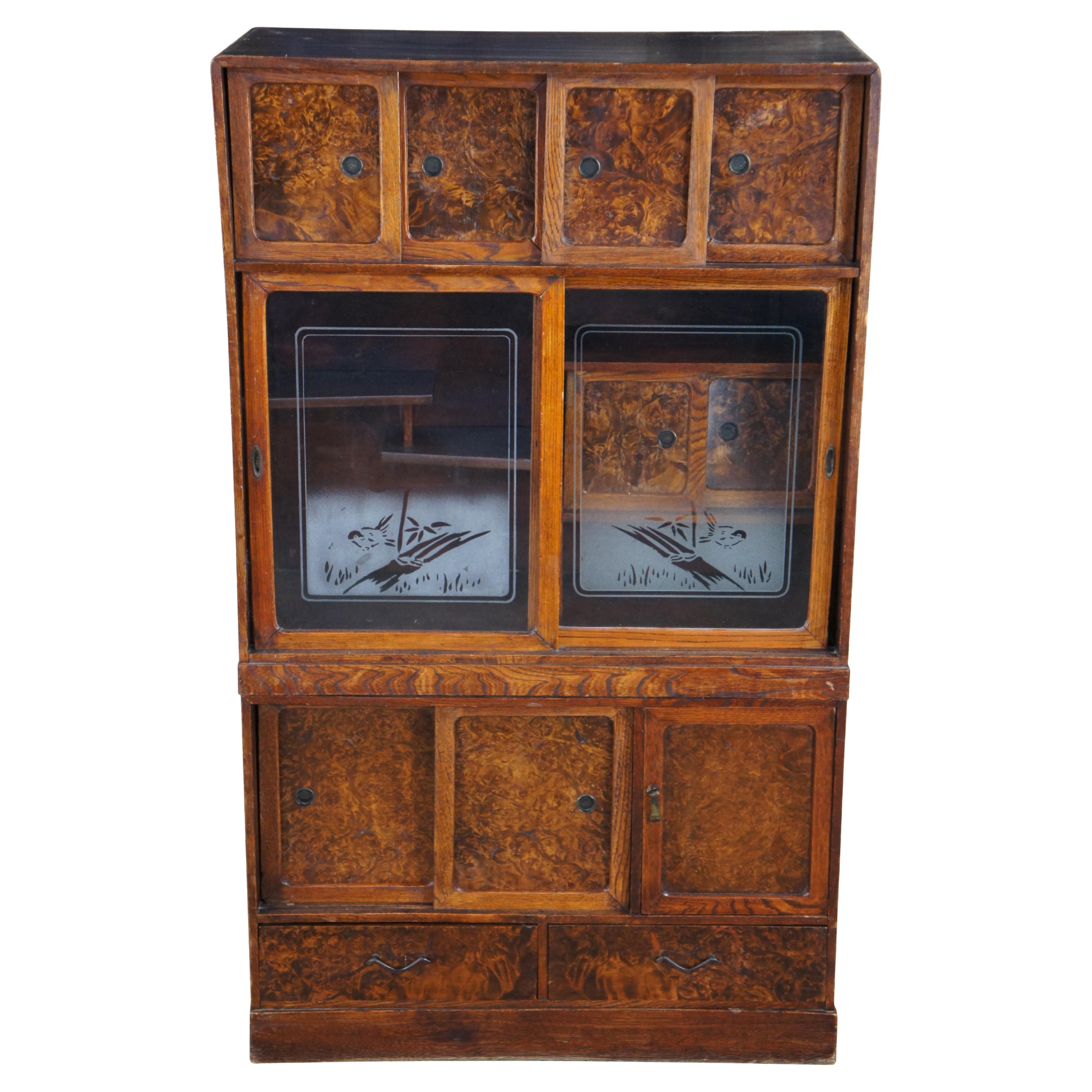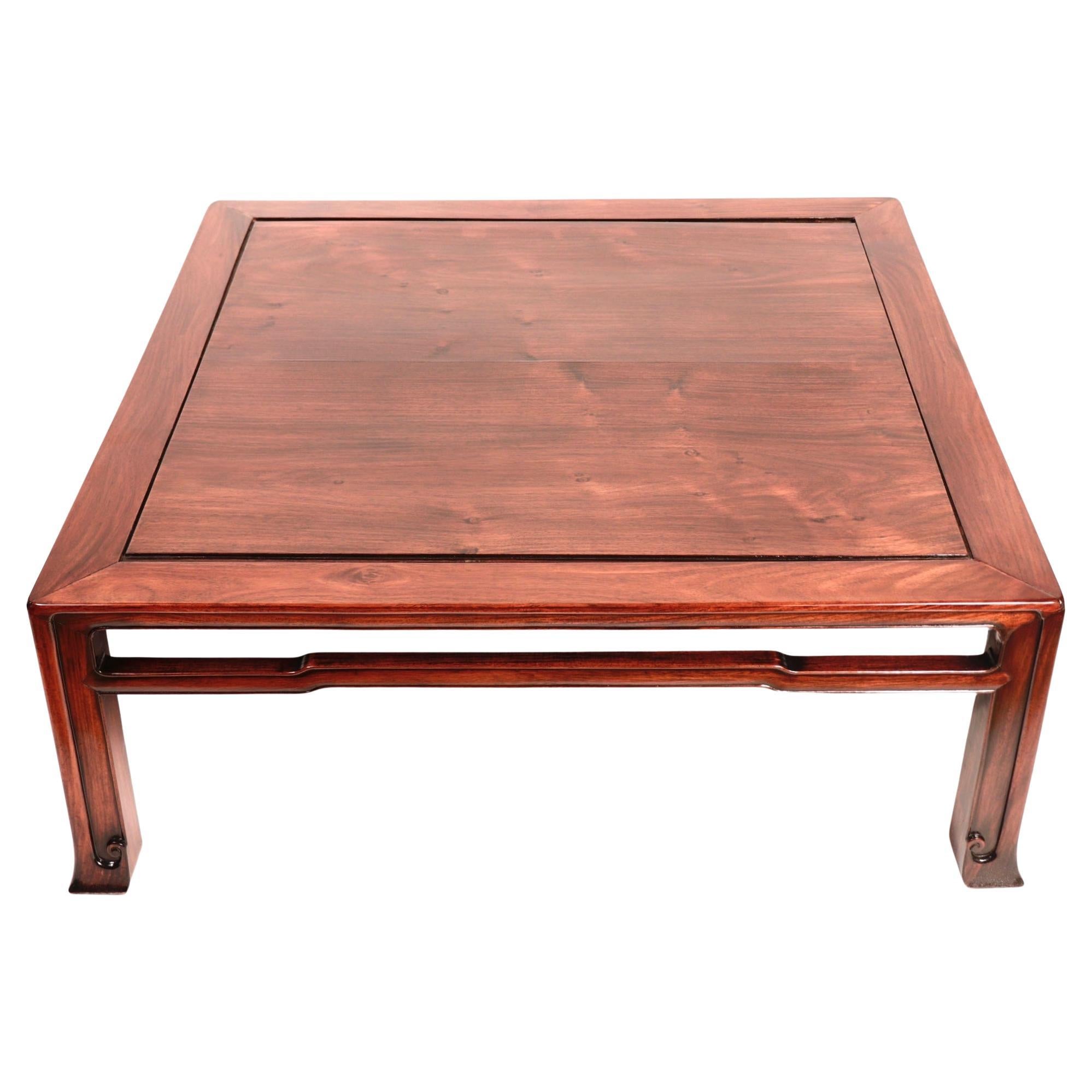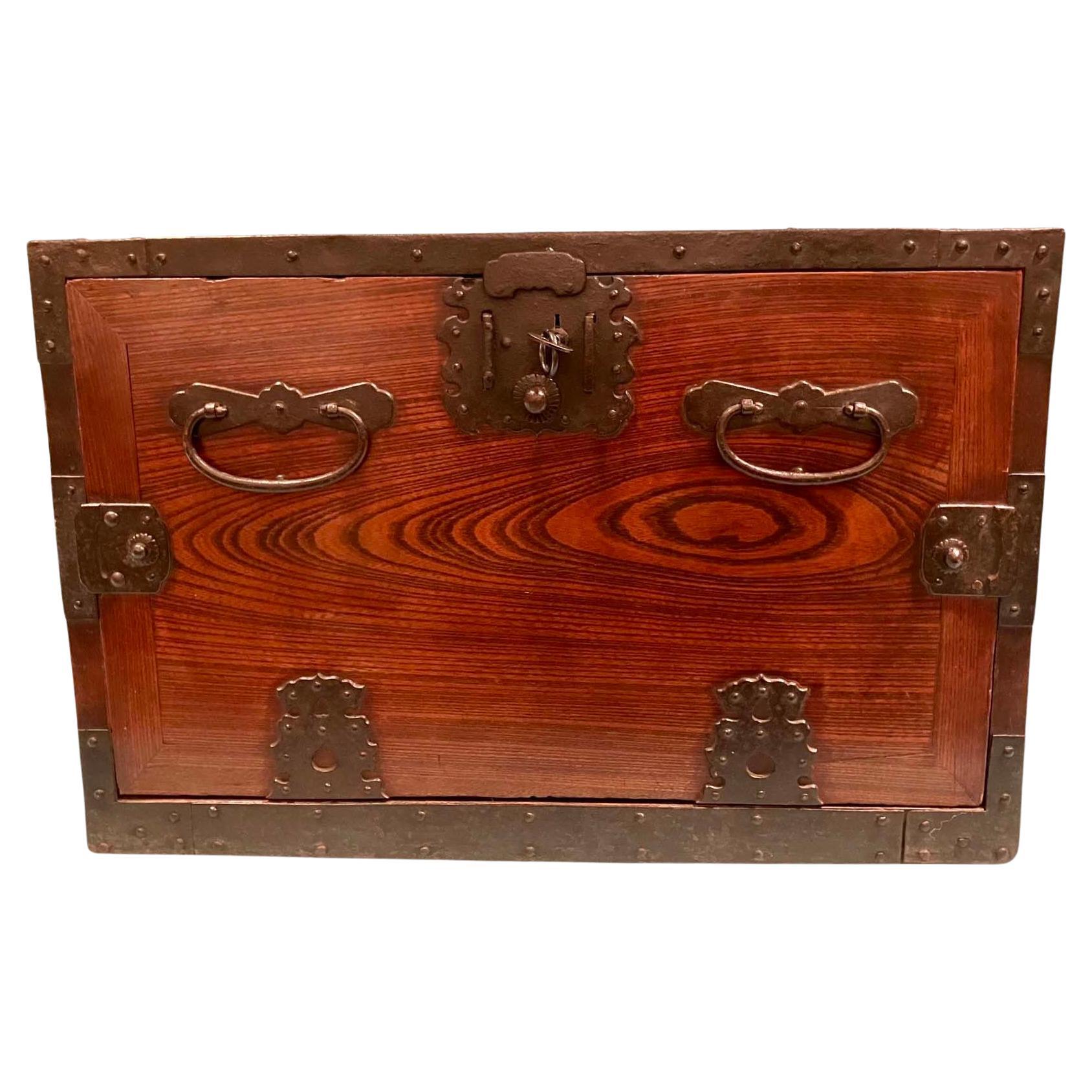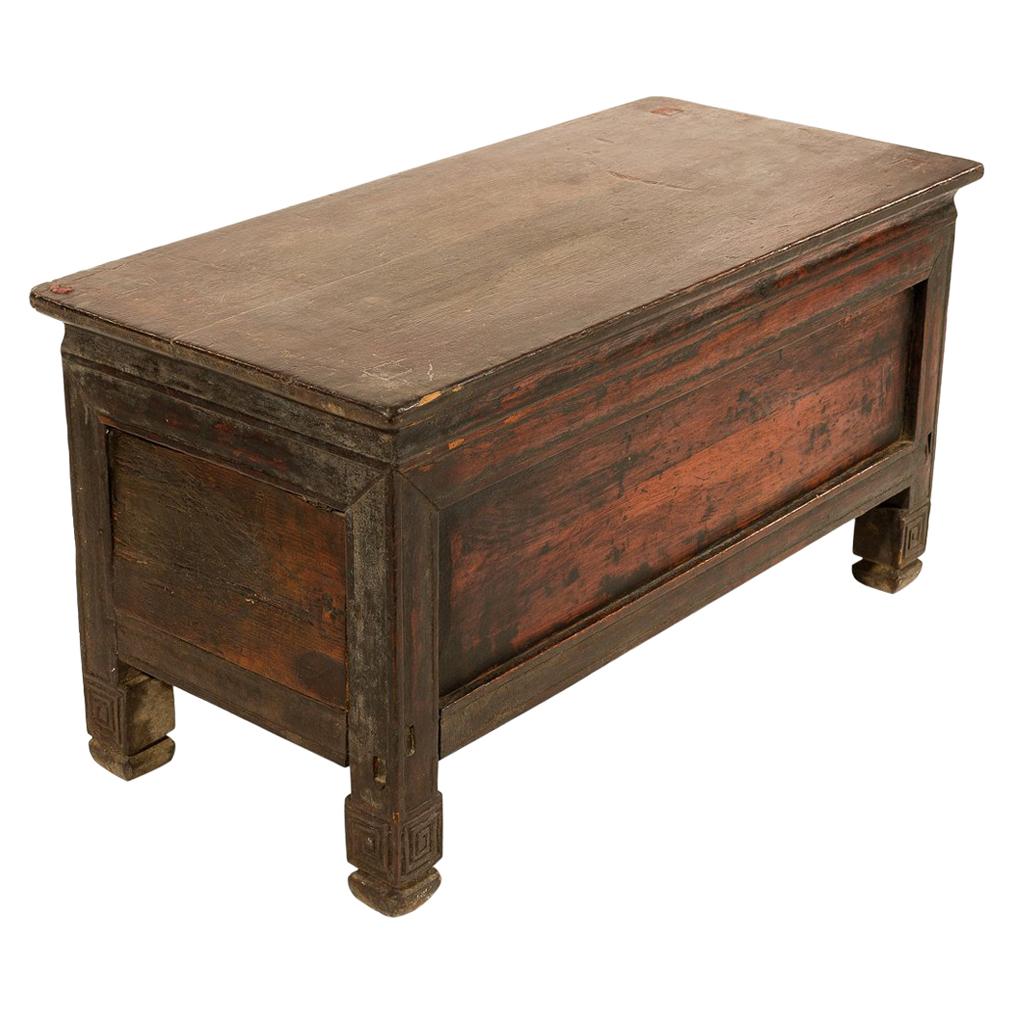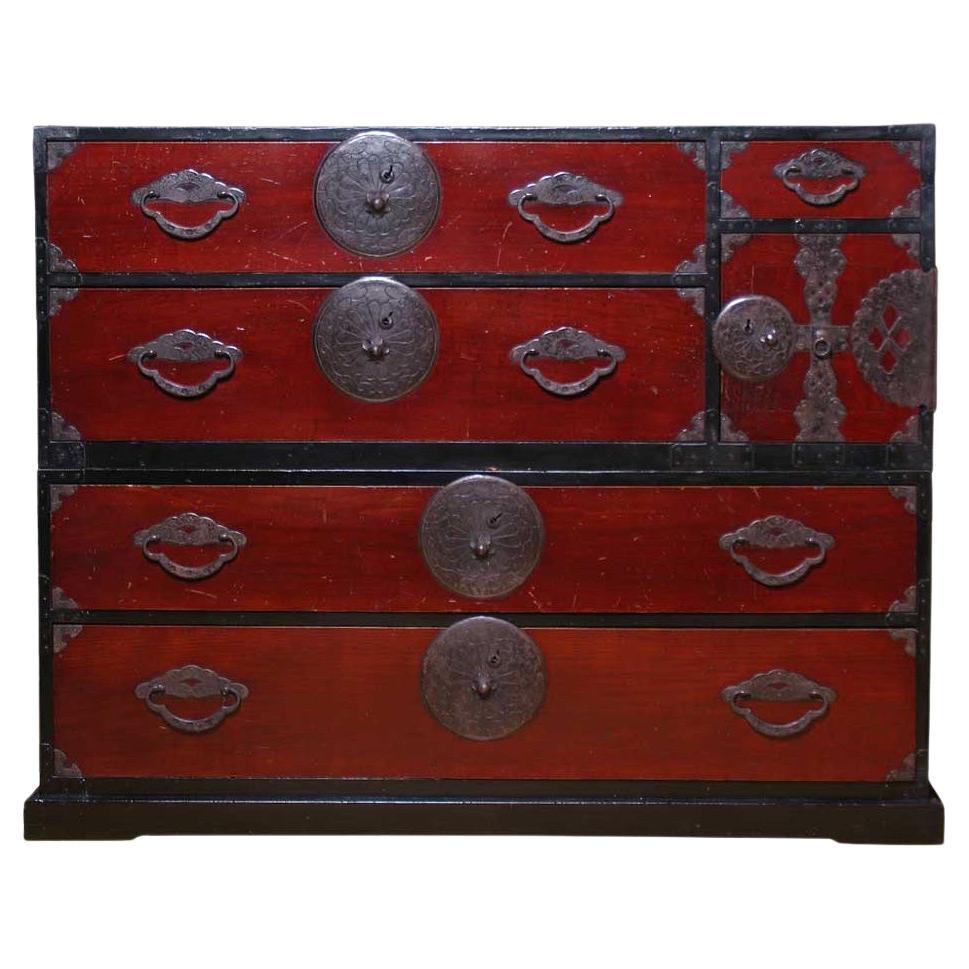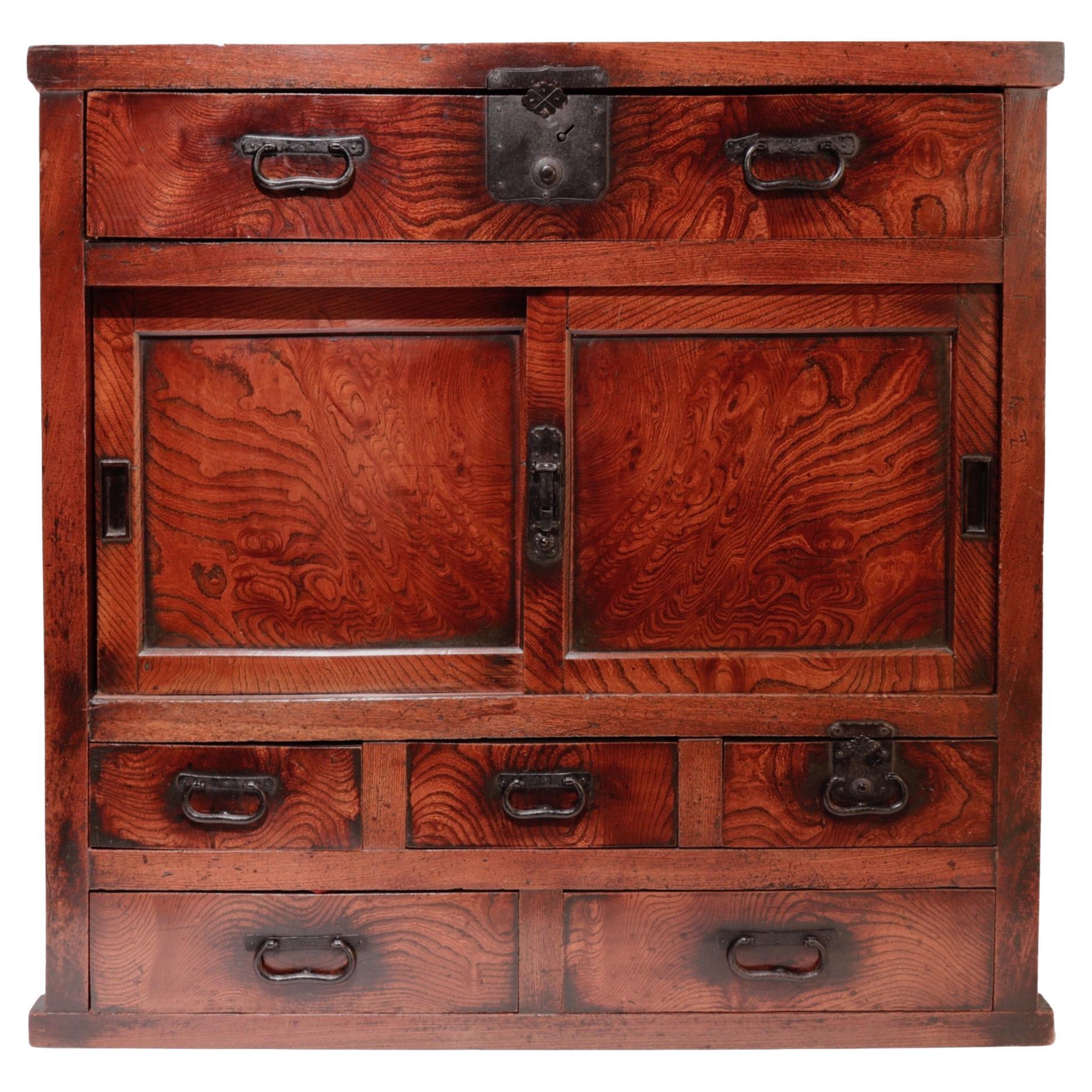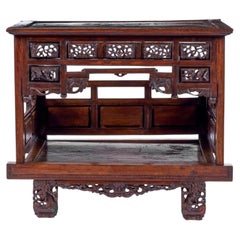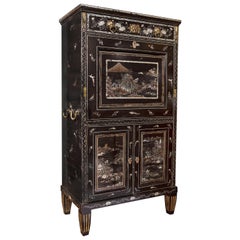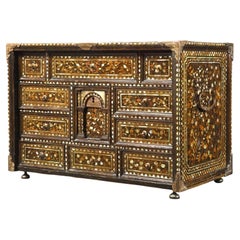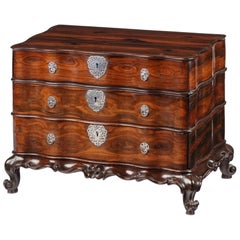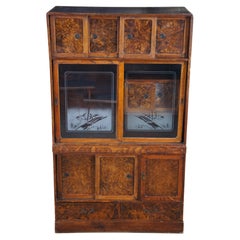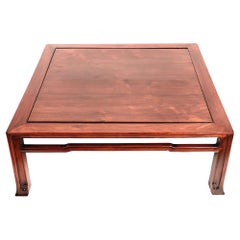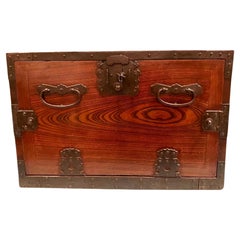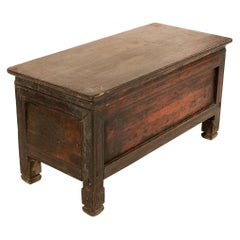Items Similar to Japanese American Cypresswood or Hirohi ‘Walsh, Hall & Co, Yokohama’ Tea Chest
Want more images or videos?
Request additional images or videos from the seller
1 of 5
Japanese American Cypresswood or Hirohi ‘Walsh, Hall & Co, Yokohama’ Tea Chest
About the Item
A Japanese Cypresswood or hirohi ‘Walsh, Hall & Co, Yokohama’ tea chest
Yokohama, 1862-1897, with inscription reading: Choicest Natural Leaf Yamashiro Tea, Packed by Walsh, Hall & Co, Yokohama
Measures: H. 53.5 x W. 61.5 x D. 41.5 cm
Including original wood box
The chest gold, silver and red lacquered on a black lacquer ground, the top decorated with an eagle sitting on a branch, looking at a small escaping bird, the front with a pheasant under a chestnut, one side with a cockerel amongst foliage, the back decorated with an argus pheasant-like bird amongst foliage. Walsh, Hall & Co. was a very successful commission trading-house in Yokohama, known as Ami-ichi (American No. 1), the first American firm to reach Yokohama in 1859. The firm was established by John Greer Walsh, and Thomas Walsh, joined by Francis (or Frank) Hall in 1861, and traded mainly in tea and silk. A colour woodblock-print by Hiroshige II (1826-1869) dating from circa 1861 titled Yokohama ijinkan no zu, shows an exceptionally faithful visual record of the Walsh, Hall & Company’s compound located at lot number two on the Bund, the Westerner’s term for the embankment along the harbour’s edge. The company’s early arrival in Yokohama secured its highly desirable location near the customhouse and one of the two stone piers. Under Frank Hall’s leadership, the business flourished. Hall, the sixth son in a family of sixteen children was born in Ellington Connecticut in 1822.
Hall graduated in 1838 from the Ellington School, founded in 1829 by his father, John Hall (1783-1847), a Yale graduate. The financial panic of 1837 made it impossible for him to attend Yale, so he took up a career as a teacher but soon gave up and moved to Elmira, New York, wherewith some financial help of two of his brothers, he opened the town’s first bookstore. Hall became a successful book dealer and his shop became the meeting place for local intellectuals and writers. In 1846 he married Sarah Covell, but unfortunately, she died rather quickly in 1848. Troubled by his wife’s death, Hall thought of leaving Elmira, but could not find a buyer for his bookstore. Finally, in. 1859 he sold his store to two of his brothers and decided to join three Dutch Reformed Missionaries on a trip to Japan as a correspondent for Horace Greely’s Tribune. Probably through mediation by Bayard Taylor, a friend of Frank Hall and America’s premier travel writer, who had gone to Japan with the Perry expedition in 1854 and had covered it for the Tribune.
Hall took up residence in Kanagawa in 1859, among a mere handful of Westerners then residing in the new Treaty Port. The seven years Hall was to be in Japan covered the most momentous period, during which the old feudal Shogunate gave way to the Meiji Restoration. Hall quickly learned Japanese and consequently not only recorded the daily life of Westerners in the treaty port in great detail but also much of the life of the Japanese around him. He published nearly seventy articles in the Tribune and kept a detailed journal that has become a major source on life in Japan during the mid-19th century. In addition, Hall was a keen photographer and serious student of Japanese plants and a friend to other ‘plant hunters’ including Philipp Franz von Siebold, George R. Hall and Robert Fortune. Unfortunately, his collection of photographs taken in Japan has yet to be rediscovered.
In 1861 Hall’s business instincts convinced him to bring some of his capital from the United States and to join the Walsh brothers in Walsh, Hall & Co. in Yokohama. In the print by Hiroshige II showing the Walsh Hall & Co. Garden in Yokohama, a shipment of George R. Hall’s plants going to the U.S. is shown. In 1866 Frank Hall returned to the United States but the firm continued under the name Walsh Hall & Co. in Yokohama until 1897 when, after the death of John Greer Walsh, the remaining interests were sold to the Mitsubishi Corporation. In 1872 Frank Hall was instrumental in sending Iwasaki Yanosuke, the man who came to head the Mitsubishi Corporation, to the exclusive (taking no more than twelve students annually) Hall Family School for Boys of his older brother Edward. After his return to Elmira, Frank Hall became a major philanthropist supporting Elmira College, the Steele Memorial Library, the Arnot-Ogden Hospital and other charities in Elmira. In 1902 he set out to build the Hall Memorial Library in Ellington Connecticut to honour the educational work of his father and brother Edward. When it was completed in 1903, the New York Tribune called it “one of the finest gifts ever made to a Connecticut town.’’ Hall also was a world traveller, for at the time of his death on August 26, 1902, the Elmira paper noted in his obituary, that “next to Bayard Taylor, he was the greatest American traveller, Greenland and Iceland being the only two countries he had not visited”. Hall’s massive and remarkable journal was only published in 1992 (F.G. Notehelfer, Japan through American Eyes: The Journal of Francis Hall, Kanagawa and Yokohama, 1859-1866. Princeton University Press).
The Walsh brothers had originally gone to China. John Greer Walsh came to Nagasaki in 1859 where he served as American Consul until mid-1860s. Walsh and Co’s agent in Kanawaga-Yokohama was the plant-hunter George R. Hall, who had been a doctor in China and came to Yokohama to trade in 1859 when the Harris Treaty first opened the port. It was George Hall (not related to Francis Hall) who insisted on Yokohama as the site for Walsh &
Co and selected the plot of land, No. 2 on the Bund. Dr. Hall’s name was not on the firm because he did not invest his money in it. When Francis Hall joined the Walsh Brothers as a full partner with his own capital in 1862, the firm was renamed “Walsh, Hall & Co. For a discussion of the Walsh Brothers see Norman and Nancy Bertram Beecher, Fortunate Journey, Concord, Mass, Norman Beecher, 1993.
- Dimensions:Height: 20.87 in (53 cm)Width: 24.02 in (61 cm)Depth: 16.15 in (41 cm)
- Sold As:Set of 2
- Style:Meiji (Of the Period)
- Materials and Techniques:
- Place of Origin:
- Period:
- Date of Manufacture:1862-1897
- Condition:Wear consistent with age and use.
- Seller Location:Amsterdam, NL
- Reference Number:1stDibs: LU5458228513832
About the Seller
5.0
Recognized Seller
These prestigious sellers are industry leaders and represent the highest echelon for item quality and design.
Established in 1985
1stDibs seller since 2020
23 sales on 1stDibs
Typical response time: 3 hours
- ShippingRetrieving quote...Shipping from: Amsterdam, Netherlands
- Return Policy
Authenticity Guarantee
In the unlikely event there’s an issue with an item’s authenticity, contact us within 1 year for a full refund. DetailsMoney-Back Guarantee
If your item is not as described, is damaged in transit, or does not arrive, contact us within 7 days for a full refund. Details24-Hour Cancellation
You have a 24-hour grace period in which to reconsider your purchase, with no questions asked.Vetted Professional Sellers
Our world-class sellers must adhere to strict standards for service and quality, maintaining the integrity of our listings.Price-Match Guarantee
If you find that a seller listed the same item for a lower price elsewhere, we’ll match it.Trusted Global Delivery
Our best-in-class carrier network provides specialized shipping options worldwide, including custom delivery.More From This Seller
View AllPeranakan Djati Wood Miniature Bed for an Anak Ambar, a Miscarried Fetus
Located in Amsterdam, NL
A Peranakan djati wood miniature bed for an Anak Ambar, a miscarried fetus
Indonesia, Peranakan Chinese, late 19th century
Measures: H. 41 x L...
Category
Antique Late 19th Century Indonesian Furniture
Materials
Wood
Japanese Export Lacquer Mother-of-Pearl Secretaire for the American Market
Located in Amsterdam, NL
A rare Japanese export lacquered secretaire for the American market
Circa 1800-1830, Colonial
Overall densely decorated with flower sprays and landscapes, minutely inlaid with ...
Category
Antique 1810s Japanese Edo Furniture
Materials
Mother-of-Pearl, Wood
Portuguese-colonial Japanese Namban lacquer Vargueno Cabinet, circa 1600
Located in Amsterdam, NL
A Portuguese-colonial Japanese Namban lacquer vargueno cabinet
Momoyama period, circa 1600
H. 43 x W. 64.5 x D. 36 cm
Wood, black lacquered and deco...
Category
Antique Early 1600s Japanese Antiquities
Materials
Gold, Brass
A Dutch-colonial Sri Lankan coromandel wood miniature chest of drawers
Located in Amsterdam, NL
A Dutch-colonial Sri Lankan coromandel wood miniature chest of drawers with silver mounts
Sri Lanka, 18th century, circa 1750
H. 35 x W. 48 x D....
Category
Antique 18th Century Sri Lankan Dutch Colonial Furniture
Materials
Silver
Rare Charming 17th Century Japanese Lacquer Cabinet with Gilt-Bronze Mounts
Located in Amsterdam, NL
A fine Japanese pictoral style lacquer cabinet with gilt-metal mounts
Kyoto, Edo period, 1670-1690
Decorated in Japanese relief lacquer work, black lacquer ground decorated...
Category
Antique Late 17th Century Japanese Furniture
Materials
Bronze
$44,129 Sale Price
25% Off
Free Shipping
Sri Lankan Mãrã or East Indian Walnut ‘Burgomaster’ Chair
Located in Amsterdam, NL
A Sri Lankan mãrã or East Indian walnut ‘Burgomaster’ chair
Galle, early 19th century
Measures: H. 81.5 x W. 74 cm / seat height 45.5 cm / seat di...
Category
Antique Early 19th Century Sri Lankan Dutch Colonial Furniture
Materials
Rattan, Hardwood
You May Also Like
Late Meiji Japanese Cha Tansu Tea Chest Display Cabinet Cupboard 45"
Located in Dayton, OH
An antique Meiji era Cha Tansu Tea Cabinet. Features a burled frame. Features a central display portion with etched glass covering shelves and upper and lower cupboard with sliding...
Category
Antique Late 19th Century Meiji Furniture
Materials
Hardwood, Burl
$1,440 Sale Price
20% Off
Japanese Rosewood Square Tea Table
Located in Point Richmond, CA
Japanese Rosewood Square Tea Table in Chinese style having tapered legs with bracket hoof feet, elbowed cross struts and center floating panel. Minor shrinkage, surface scratches, an...
Category
Antique Early 1900s Japanese Meiji Furniture
Materials
Rosewood
Japanese Meiji Period Elm and Iron Bound Table Tansu or Sea Chest
Located in San Francisco, CA
A Japanese Meiji period iron mounted sea chest or table cabinet, the removable front cover opening to reveal an interior with 5 drawers of varying sizes. The piece is mounted with de...
Category
Antique Mid-19th Century Japanese Meiji Furniture
Materials
Iron
Antique Tibetan Wooden Tea Table, Storage Box or Chest
Located in New York, NY
Totally handmade from beautiful hardwood with lots of patina, surface markings and cool vibe from over a century's use in Tibet. This piece is beautifully crafted with all dovetails ...
Category
Antique Mid-19th Century Tibetan Tibetan Furniture
Materials
Wood
$1,540 Sale Price
30% Off
Japanese Tansu, chest-on-chest (isho kasane-dansu), Yonezawa
Located in Point Richmond, CA
Japanese chest-on-chest for clothing storage (isho kasane-dansu) from Yonezawa, constructed of hinoki (Chaemaecyparis obtusa) and keyaki (Zelkova serrata) drawer fronts, traditional ...
Category
Antique Late 19th Century Japanese Meiji Furniture
Materials
Wood
Japanese Merchant’s chest (choba-dansu), Toyama
Located in Point Richmond, CA
Japanese Merchant’s chest (choba-dansu), Toyama, the front entirely constructed of keyaki (Zelkova serrata), original fuki-urushi lacquer fini...
Category
Antique Late 19th Century Japanese Meiji Furniture
Materials
Hardwood
Recently Viewed
View AllMore Ways To Browse
Dior Asia
Tea Chest
Black Japanese Chest
Antique Japanese Book
Antique Hall Chest
Asian Silk Art Birds
Frank And Son Furniture
Antique Hospital Furniture
Asian Stone Head
Japan Tea Box
Japanese Antique Wood Birds
American Chestnut
19th Century Japanese Chest
Meiji Woodblock
Lacquer Chest Japan
Antique Japanese Silver Box
Silver Antique Japanese Boxes Silver Boxes
Chinese Chest Red
